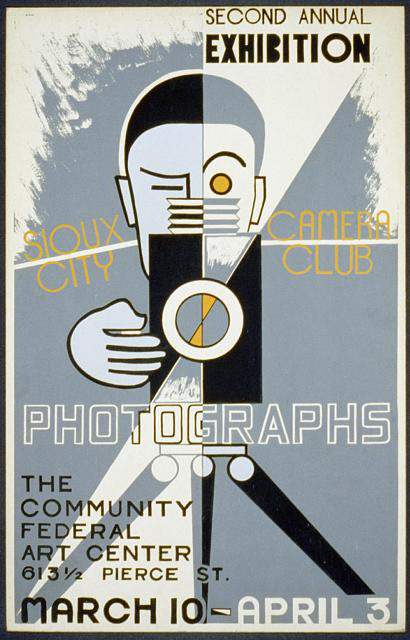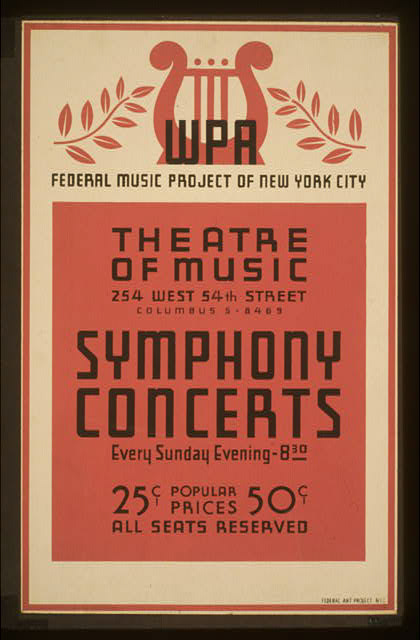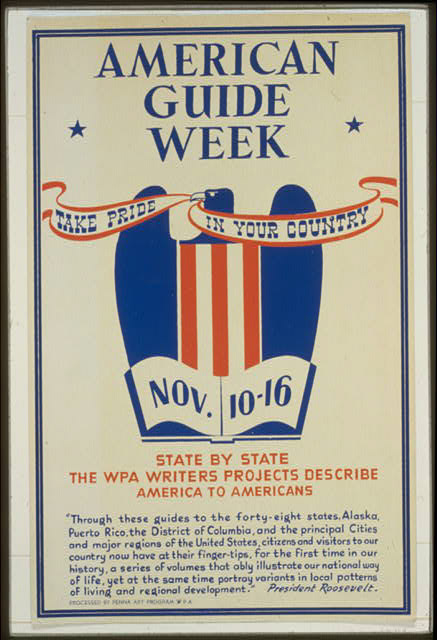By Isaac Lorton
The Great Depression shook the collective psyche of the nation. It dropped society into a sudden existential crisis and made people think about what they wanted to see still standing when it recovered. What would the pillars of the republic be post-depression?
In those trying times, people turned to the arts and humanities. Realizing this, a large portion of the New Deal went to the Works Progress Administration (WPA) and a small, yet significant slice of the WPA went to the Federal Project Number One, which funded five programs: the Federal Art Project, the Federal Music Project, the Federal Theatre Project, the Federal Writers’ Project, and the Historical Records Survey.
Of the cultural projects of the WPA, Cedric Larson wrote in the Public Opinion Quarterly in 1939, "The impact made by the five major cultural projects of the WPA upon the national consciousness is probably greater in toto than anyone readily realizes. As channels of communication between the administration and the country at large, both directly and indirectly, the importance of these projects cannot be overestimated, for they all carry a tremendous appeal to the eye, the ear, or the intellect—or all three."

Public Domain Image Courtesy of the Library of Congress

Public Domain Image Courtesy of the Library of Congress

Public Domain Image Courtesy of the Library of Congress
Now in 2020, in the tempest of the COVID-19 pandemic, our country is grappling with similarly daunting circumstances, and again people are turning to the arts and humanities. People are creating and consuming more art. Yet, many arts and humanities organizations, as well as individuals artists, are struggling to remain financially viable. This is especially true of ticket-based organizations, which Deputy Director of the Vermont Arts Council Amy Cunningham said were like “canaries in the coal mine” before shelter-in-place orders were given in Vermont and New Hampshire because ticket sales stagnated.
Ginnie Lupi, Director of the New Hampshire State Council on the Arts, said of the pandemic’s effects on arts and culture organizations, “All organizations are experiencing severe financial impact. Presenting organizations—theatres, concert halls and production companies—have been dark for over six weeks, with no revenue. Most have had to furlough staff and many have canceled performance seasons. Same for the state's museums and galleries. Community music, art, and theatre schools have adapted to physical distancing requirements by taking their classes, lessons and programs online, but they too are experiencing significant losses. Reopening these organizations will present another set of challenges, due to distancing and hygiene requirements and the willingness of audiences to return.”
Like Federal Project Number One during the Great Depression, the CARES Act did not leave the arts and humanities organizations out of the relief package. The National Endowments for the Arts and Humanities each received $75 million through the CARES Act and then allocated money to the states. The New Hampshire State Council on the Arts received $427,000 in CARES Act funding, New Hampshire Humanities received $370,200 and the Vermont Arts Council and Vermont Humanities Council combined their allotted funds to create a pool of just over $700,000. These councils sprang to create emergency grant programs to quickly, efficiently, and equitably distribute relief grants to help make sure the creative economy survives. Executive Director of the Vermont Humanities Council Christopher Kaufman Ilstrup said in many ways, VHC is “working harder than they ever have,” to evaluate the influx of grant relief requests.
“When we’re evaluating these grants… we’re looking that they have a demonstrated need—that they’re actually losing money, that they’re in danger of losing their space, losing their staff, closing their doors; that we’re offering some kind of extra point if you’re serving marginalized communities—Can you demonstrate that you are serving a low-income community, or an underserved community that doesn’t have a lot of cultural opportunities? Are you led by or serving LGBT folk or people of color in your community? Do you have a sense of what it means to serve a marginalized or an underserved population?; that we are really trying to make grants that cover a variety of disciplines; ...that we’re making grants as much as we can across all 14 counties with some eye towards populations centers,” Kaufman Ilstrup said. “It would be very easy for us to make a decision to support just the very large organizations in the state of Vermont that are primarily concentrated in the northwest in the Burlington area, but that’s not the choice that we’re making. We want to make sure we’re supporting arts organizations across the state, including the Upper Valley.”

Public Domain Image Courtesy of the Library of Congress

Public Domain Image Courtesy of the Library of Congress

Public Domain Image Courtesy of the Library of Congress
According to the Economic Impact of the Coronavirus on the Arts and Culture Sector survey by Americans for the Arts as of May 5, 101 NH organizations have reported a loss of $1,869,150 and 242,954 patrons. The 129 VT organizations that responded reported a loss of $3,704,242 and 252,741 patrons. The negative numbers keep growing, Cunningham said.
“Small—even the large—performing arts organizations operate on really thin margins,” Cunningham said. “Ticket revenues are important but sponsorships are also important, and of course if local businesses are also struggling and having their own issues, that is a problem. Individual donors and donor bases for different organizations, in some cases, those folks are understandably deciding to convert contributions to urgent human needs right now. There are many layers.”
The funding from the CARES Act is not enough now and will not be enough when organizations begin operating again, Kaufman Ilstrup said. Of the $41.7 billion New Deal, $27 million went to the Federal Project Number One (0.064% or like getting 64-cents out of a $1,000). Of the approximately $2 trillion of the CARES Act, the $150 million given to the National Endowment of the Arts and Humanities is 0.0075% (like getting 75-cents out of $10,000). If the $50 million allocated to the Institute of Museum and Library Services is included, it is still only 0.01%—like getting 1-cent out of $1,000. Using an inflation calculator, $27 million in 1935 would be approximately $500 million today.
“We don’t have enough money to meet the need, and that’s very clear,” Kaufman Ilstrup said. “...The need is several million dollars and growing everyday. There’s no physical way to meet the need with the amount of resources we have. So the first thing that I’d say is we’ve got to continue to advocate, and we’d urge all arts organizations, cultural organizations, and their fans to continue to advocate with Congress for more support for the cultural sector.”
Both Vermont and New Hampshire have also launched relief efforts for individual artists: musicians, actors, writers, painters, photographers, graphic designers. Gig workers. People who go from show to show, or concert to concert, exhibit to exhibit, or event to event. The relief grants will fund practicing artists, whether their art is their primary full-time job or a secondary part-time job. If an artist loses their full-time, non-art job and is unable to create art because it funded their work, they are able to apply. In both states this is being done with private funding and individual donations not provided by the CARES Act. Under Federal Project Number One, such artists as Ralph Ellison, Nora Zeal Hurston, and John Steinbeck, were employed.

Public Domain Image Courtesy of the Library of Congress

Public Domain Image Courtesy of the Library of Congress

Public Domain Image Courtesy of the Library of Congress
Lupi said, ”Individual artists of all disciplines are also suffering greatly in the pandemic. Most are self-employed and depend on public gigs, residencies, shows and events for their livelihoods. We are glad that New Hampshire led the way in expanding unemployment insurance to include the self-employed and that the federal government followed suit, but more assistance will be needed for artists, particularly because reopening will be a slow process.”
Vermont is also providing unemployment insurance for self-employed workers, and Cunningham said that the Rapid Response Artist Relief of VAC and VHC has already received 400 applications requesting relief and issued more than $64,435 of funds for 164 artists.
“We’ll double that at the very least in the coming weeks,” Cunningham said. “We’re looking to support individual creatives as well as organizations.”
Federal Project Number One funded 40,000 artists with the dual-purpose of providing jobs for artists—at the same level as other sector workers—and acknowledging that pursuits in the arts and humanities were just as vital to a solid economy. Or as the Secretary of Commerce Harry Hopkins at the time put it at the time, “Hell, they’ve got to eat, too.”
Though many arts and culture organizations are currently in the reaction period of the situation, as they begin looking forward to if they do survive this, Kaufman Ilstrup stressed how we, as a society, must be patient and remember how intertwined the creative economy is with the overall economy.
“Everybody is concerned about when they can possibly start doing programming again,” Kaufman Ilstrup said. “I think, increasingly, people are coming to the realization that we’re not going to flip a switch and go back to January of this year—that it’s going to be a long, slow recovery, and there’ll be a lot of both fits and starts—but also we’re going to have to learn how to do things a little bit differently in the future.
“There’s so many different ways that the cultural sector connects to the larger sector, that it’s impossible to isolate it out and say, we just have to wait on [helping] the cultural sector until we’ve taken care of these other things. We are integrated fully and completely into the rest of the economy. And we have a role to play in the recovery.”
For VT artists and arts and humanities organizations looking for more information about relief funding, click HERE. For NH artists and arts organizations seeking information, go HERE. For NH humanities organizations, click HERE.
To fill out the Americans for the Arts' Economic Impact of the Coronavirus on the Arts and Culture Sector survey or to see the corresponding dashboard, visit HERE.
If you thought the WPA Federal Project One posters were cool, browse through them HERE at the Library of Congress site.
May, 2020
Isaac Lorton is thrilled to be writing, editing, and photographing in the Twin State region. Simply, Isaac is happy to be here in this place at this moment with this group of people.
